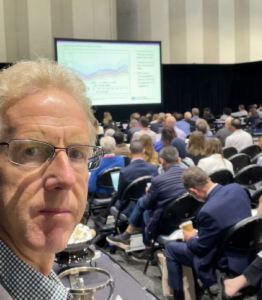JH Explorer in San Diego: The future of treating diabetes
Portfolio Manager and Research Analyst Dan Lyons attends the annual conference of the American Diabetes Association (ADA) to hear what doctors and thought leaders are saying about a new class of diabetes drugs.

4 minute read
Key takeaways:
- New innovations in the class of diabetes therapies called GLP-1 agonists have shown the potential to not only lower blood sugar levels in patients but also deliver greater weight loss and reduce cardiovascular risks.
- These and other findings were explored during the annual ADA conference, where doctors and researchers provided context for clinical data.
- These discussions made clear that the GLP-1 class has the potential to transform the standard of care not only for diabetes but also for obesity and cardiovascular disease.
| The JH Explorer series follows our investment teams across the globe and shares their on-the-ground research at a country and company level. |
On and off over the past 20 years, I have attended the annual meeting of the American Diabetes Association (ADA), which each year convenes thousands of physicians, scientists, investors, and companies to discuss the latest developments in treating this global endocrine disease. This year’s conference took place in late June in San Diego, and it wasn’t just the location’s sandy beaches that lured me to attend (after several year of participating virtually during COVID-19). Rather, the event presented a unique opportunity to speak with doctors, researchers, and management teams just as the approach to addressing diabetes is reaching a key inflection point.
New medicines that go beyond lowering blood sugar
In fact, it wasn’t long ago that interest in the ADA conference and diabetes generally was waning. The reason had to do with a mandate from the Food and Drug Administration (FDA) requiring companies to prove that new products would not only lower blood sugar (which numerous therapies already did) but also improve other outcomes, such as reducing the risk of cardiovascular disease. With some companies reticent to invest in costly clinical trials that might not yield a definitive benefit, innovation slowed.

Even so, in the late 2000s and early 2010s, companies began pursuing a new class of drugs known as glucagon-like peptide-1 agonists, or GLP-1. The drugs mimic the GLP-1 gut hormone, which helps regulate blood sugar levels by stimulating the production of insulin, which diabetics lack. In clinical trials, researchers observed that the agonists also suppressed appetite and sometimes reduced the risk of adverse cardiovascular events.
Companies began to invest in further research, and the results are now coming in: Over the past year, GLP-1s have shown the ability to deliver weight loss of more than 20% in late-stage clinical trials – a level previously achieved only through surgery. Most recently, one GLP-1 drug showed it can lower the incidence of heart attack, stroke, or death from heart disease by 20%, exceeding Wall Street analyst expectations. The outcome is now helping build the case that these drugs could be widely adopted and reimbursed by health systems globally, not just for diabetes but also for obesity and cardiovascular disease.
A chance to gather context for clinical data
The ADA conference spanned four days over a long weekend. In a large convention hall, companies set up booths with espresso machines, providing a free dose of caffeine for attendees and the opportunity to mingle with physicians and researchers.
These encounters are valuable in that they offer a chance to ask questions and gather context for clinical data published in medical journals: How do doctors perceive the safety and efficacy of the new therapies relative to the existing standard of care? What is the reasoning behind the design of clinical trials and how does that impact outcomes? How are other investors reacting to the data?

In addition to discussions at company booths, attendees can listen to data presented at the conference’s general and breakout sessions, as well as go to firm-sponsored events in the evenings – another way to gauge interest in new science by observing who foregoes a Saturday night to attend.
One final attraction is the rows of scientific posters on display in the convention hall. Researchers and physicians present their latest clinical data on posterboards and make themselves available to answer questions. These posters can attract throngs of people, creating the opportunity to bump into industry heavyweights. For me, that included the CEO of a private company in which JHI has recently become an investor. While she and I have often talked over Zoom, this was our first in-person meeting and provided a unique chance to hear her perspective on how the market – and where her company will be competing in the coming years – is shaping up.
 At the end of the weekend, I came away feeling enthusiastic about where diabetes research – and its potential implications for weight loss and cardiovascular health – is headed. The event also helped me go into more depth on individual companies, including one whose presentation offered tantalizing early clinical data on another mechanism of action that would be disease-modifying, inhibiting a protein that slows the generation of healthy insulin-producing beta cells in the pancreas.
At the end of the weekend, I came away feeling enthusiastic about where diabetes research – and its potential implications for weight loss and cardiovascular health – is headed. The event also helped me go into more depth on individual companies, including one whose presentation offered tantalizing early clinical data on another mechanism of action that would be disease-modifying, inhibiting a protein that slows the generation of healthy insulin-producing beta cells in the pancreas.
Overall, given the strength of data presented at the conference and the potential scope for more development, I believe diabetes could be at the beginning of a significant runway of growth. I’m already looking forward to seeing how things have progressed at next year’s event.


